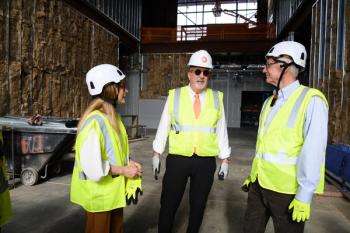
State funding boost quells CSU cutback concerns
Fort Collins - A financial reprieve in the form of a million-dollar boost from the state means a Colorado teaching hospital won't have to sacrifice personnel for a balanced budget.
Fort Collins — A financial reprieve in the form of a million-dollar boost from the state means a Colorado teaching hospital won't have to sacrifice personnel for a balanced budget.
Still, there have been some casualties among the hospital crew despite the lack of layoffs, with the May 14 resignations of James L. Voss Veterinary Teaching Hospital Director Dan Smeak and Administrator Chris Grippo.
The university on May 21 appointed Dr. Dean Hendrickson as interim director and Joe Schwarz as interim administrator while it searches for permanent replacements. Both have previously worked in administrative capacities for the hospital, which should help as the VTH battles its budget problems.
Dr. Lance Perryman, dean of the College of Veterinary Medicine and Biomedical Sciences at Colorado State University announced May 8 that the state Legislature approved $1 million in new funds for the hospital to alleviate a $1.5 million deficit brought on by the sluggish economy and a subsequent decrease in hospital revenue.
"We are all aware of the economic downturn in our nation. ... Economic pressures reduce discretionary income available to pet and livestock owners for care of their animals," Perryman says.
The teaching hospital, which serves more than 200 veterinary students, annually reviews and adjusts its prices to match its fixed expenses, Perryman says, but the combination of a slight reduction in caseloads and a decrease in the amount clients are willing to spend has resulted in the deficit.
The university will match the state's $1 million contribution, Perryman says. The new funds will allow the hospital to clear its deficit without any layoffs, but several vacant positions won't be filled for the time being, he added.
"While we greatly appreciate the $1 million in new base support, the additional matching funds are essential to prevent personnel layoffs that would have been required to achieve a balanced hospital budget during the current economic downtown," Perryman says in his May 8 statement. "I am pleased that matching funds from the university and the dean's office should enable us to avoid personnel layoffs in the [hospital] for economic reasons."
Sen. Steve Johnson, a 1986 graduate of CSU's College of Veterinary Medicine and Biomedical Sciences, sought additional funding for the university's teaching hospital after it was discovered that Colorado was providing only about 29 percent of what other states supply to their veterinary teaching hospitals.
"The outstanding administrators at CSU have stretched state dollars as much as they can, and the strain is beginning to be felt as fees increase at the hospital and caseload faces declines, threatening the learning experience for our students," Johnson says.
The teaching hospital is considered a very important asset by the state, and Johnson says a recent voter initiative allowing more flexible spending means Colorado can increase its contribution to the university.
"It's an attempt to get our medical school and vet school more on par with what other states are doing," Johnson says.
However, once the Legislature approved the additional hospital funding to the university, normally granted a great amount of flexibility with its state funds, some tension arose, Johnson explains. In its voting on the $1 million funding increase, Johnson says the Legislature directed that money go alleviate the hospital's projected $1.4 million budget shortfall.
"That created a little bit of disagreement between the university, which was used to a great deal of flexibility, and the Legislature," Johnson says.
Addressing reports from news agencies that the university planned to use some of the state money to fund a hospital spay-and-neuter program, Johnson says the Legis-lature made it clear that the funds only were to be spent on shoring up the hospital budget. Once the funds are sent to the university and used, Johnson says he will request a statement verifying they were spent according to the Legislature's wishes.
"I think in this case it would be wise, and I plan to ask for an accounting on how that money was spent," he says.
To clarify, Dell Rae Moellenberg, CSU's senior media and community relations coordinator, says there now is a deficit in the spay-and-neuter program, which falls under the hospital's budget. Some funds may be used to address that $40,000 shortfall. There has been no misuse of state funds, Moellenberg adds, and the university is not even set to receive the new state monies until July 1. A letter from the university already was sent to the Legislature's Joint Budget Committee stating its intent to use the funds only to reduce the VTH deficit, she added.
Perryman also affirmed that the state funds would be used to clear the hospital's deficit.
"What is happening is that the university is providing the necessary funds to resolve our deficit for this fiscal year; then, beginning next fiscal year, we will receive a $1 million annual allocation from the Legislature to help with the operating costs of the hospital," Perryman says.
The continued deficit also will be managed with cost reductions throughout the veterinary college's $120 million budget, from which the VHT receives its funding, Moellenberg explains.
The last time the hospital faced a deficit was in 2004, according to a financial statement provided by the university. The deficit then was less than $500,000. For 2007-08, the university projected revenue at $12.8 million and only realized about $11.5 million as of April. Its fiscal year ends June 30. Actual revenue exceeded projections by about $400,000 last year, according to the statement.
Colorado news agencies also reported that the May 14 announcement of Smeak's and Grippo's resignations was related to the budget problems and disagreements over how the state funds could be spent.
In speaking with both Smeak and Grippo, Johnson says he felt there might have been some political tensions between the hospital directors and the university over how the state money would be spent.
"As far as I'm concerned they are excellent administrators," Johnson says of Smeak and Grippo. "I think they were trying to do a difficult job of bringing order [to the budget problems]. I'm very sad to see them go."
However, the university asserted that neither Smeak nor Grippo was forced out, but resigned voluntarily — Smeak to return to surgery and teaching, and Grippo to pursue other unspecified opportunities.
Grippo could not be reached for comment, and Smeak declined comment at press time. The university declined further comment on the resignations, citing privacy issues.
Prior to taking over as hospital director last August, Smeak worked 28 years as a clinical surgeon and teacher at The Ohio State University College of Veterinary Medicine. He says in his resignation statement that the transition from teacher and surgeon to administrator was rewarding but difficult.
"I look forward to pursuing my passion and getting back to my roots — surgery — once again, doing what I do best," Smeak says in a letter about his resignation. His immediate plans, he writes, are to work at the hospital as a soft-tissue surgeon and teacher.
"We are pleased that Dr. Smeak has decided to stay on as a small-animal surgeon at Colorado State, and we look forward to supporting him fully in that new role," Perryman says. "We know that our students, clients and patients will all benefit greatly from his skills."
Hendrickson "served as interim [director] from December 2006 to July 2007 and did an outstanding job," Perryman says, adding that Hendrickson is a board-certified equine surgeon who has great communication skills and previously operated the hospital on a balanced budget.
Schwarz previously served 25 years as hospital administrator before retiring last year. Perryman says the university convinced him to return on a short-term basis. He says Schwarz has great human resource and business skills.
Both interim administrators will work at the hospital for six months to a year, Perryman says.
"During that time, we will complete the reorganization of our administrative team structure in the hospital, and as soon as that is done we will then appoint a permanent director," Perryman says. "Dr. Hendrickson certainly can and will be considered for that position."
Schwarz, however, will return to his retirement, Perryman says.
Though he wouldn't comment on the departures of the previous administrative team, Perryman says he hopes to find in a new hospital director someone who can lead and provide vision, communicate effectively with the hospital community, build an effective team, balance the budget, make decisions and meet deadlines.
Newsletter
From exam room tips to practice management insights, get trusted veterinary news delivered straight to your inbox—subscribe to dvm360.




